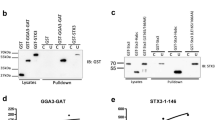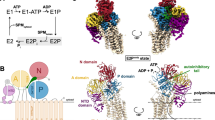Abstract
The cytosolic ATPase N-ethylmaleimide-sensitive fusion protein (NSF) disassembles complexes of membrane-bound proteins known as SNAREs, an activity essential for vesicular trafficking. The amino-terminal domain of NSF (NSF-N) is required for the interaction of NSF with the SNARE complex through the adaptor protein α-SNAP. The crystal structure of NSF-N reveals two subdomains linked by a single stretch of polypeptide. A polar interface between the two subdomains indicates that they can move with respect to one another during the catalytic cycle of NSF. Structure-based sequence alignments indicate that in addition to NSF orthologues, the p97 family of ATPases contain an amino-terminal domain of similar structure.
This is a preview of subscription content, access via your institution
Access options
Subscribe to this journal
Receive 12 print issues and online access
$209.00 per year
only $17.42 per issue
Buy this article
- Purchase on Springer Link
- Instant access to full article PDF
Prices may be subject to local taxes which are calculated during checkout




Similar content being viewed by others
References
Woodman, P. G. The roles of NSF, SNAPs and SNAREs during membrane fusion. Biochim. Biophys. Acta 1357, 155–172 (1997).
Burgoyne, R. D. & Morgan, A. Analysis of regulated exocytosis in adrenal chromaffin cells: insights into NSF/SNAP/SNARE function. Bioessays 20, 328–335 (1998).
Wilson, D. W., Whiteheart, S. W., Wiedmann, M., Brunner, M. & Rothman, J. E. A multisubunit particle implicated in membrane fusion. J. Cell Biol. 117, 531–538 (1992).
Söllner, T. et al. SNAP receptors implicated in vesicle targeting and fusion. Nature 362, 318–324 (1993).
Banerjee, A., Barry, V. A., DasGupta, B. R. & Martin, T. F. J. N-ethylmaleimide-sensitive factor acts at a prefusion ATP-dependent step in Ca2+-activated exocytosis. J. Biol. Chem. 271, 20223–20226 (1996).
Mayer, A., Wickner, W. & Haas, A. Sec18p (NSF)-driven release of Sec17p (α-SNAP) can precede docking and fusion of yeast vacuoles. Cell 85, 83–94 (1996).
Nichols, B. J., Ungermann, C., Pelham, H. R. B., Wickner, W. T. & Haas, A. Homotypic vacuolar fusion mediated by t- and v-SNAREs. Nature 387, 199–202 (1997).
Mayer, A. & Wickner, W. Docking of yeast vacuoles is catalyzed by the ras-like GTPase Ypt7p after symmetric priming by Sec18p (NSF). J. Cell Biol. 136, 307–317 (1997).
Ungermann, C., Nichols, B. J., Pelham, H. R. B. & Wickner, W. A vacuolar v-t-SNARE complex, the predominant form in vivo and on isolated vacuoles, is disassembled and activated for docking and fusion. J. Cell Biol. 140, 61–69 (1998).
Ungermann, C., Sato, K. & Wickner, W. Defining the functions of trans-SNARE pairs. Nature 396, 543–548 (1998).
Nishimune, A. et al. NSF binding to GluR2 regulates synaptic transmission. Neuron 21, 87–97 (1998).
Osten, P. et al. The AMPA receptor GluR2 C terminus can mediate a reversible, ATP-dependent interaction with NSF and alpha- and beta-SNAPs. Neuron 21, 99–110 (1998).
Song, I. et al. Interaction of the N-ethylmaleimide-sensitive factor with AMPA receptors. Neuron 21, 393–400 (1998).
McDonald, P. H. et al. Identification of NSF as a β-arrestin1-binding protein. J. Biol. Chem. 274, 10677–10680 (1999).
Wilson, D. W. et al. A fusion protein required for vesicle-mediated transport in both mammalian cells and yeast. Nature 339, 355–359 (1989).
Tagaya, M., Wilson, D. W., Brunner, M., Arango, N. & Rothman, J. E. Domain structure of an N-ethylmaleimide-sensitive fusion protein involved in vesicular transport. J. Biol. Chem. 268, 2662–2666 (1993).
Neuwald, A. F., Aravind, L., Spouge, J. L. & Koonin, E. V. AAA+: a class of chaperone-like ATPases associated with the assembly, operation, and disassembly of protein complexes. Genome Res. 9, 27–43 (1999).
Rabouille, C., Levine, T. P., Peters, J.-M. & Warren, G. An NSF-like ATPase, p97, and NSF mediate cisternal regrowth from mitotic Golgi fragments. Cell 82, 905–914 (1995).
Whiteheart, S. W. et al. N-ethylmaleimide-sensitive fusion protein: a trimeric ATPase whose hydrolysis of ATP is required for membrane fusion. J. Cell. Biol. 126, 945–954 (1994).
Nagiec, E. E., Bernstein, A. & Whiteheart, S. W. Each domain of the N-ethylmaleimide-sensitive fusion protein contributes to its transport activity. J. Biol. Chem. 270, 29182–29188 (1995).
Matveeva, E. A., He, P. & Whiteheart, S. W. N-ethylmaleimide-sensitive fusion protein contains high and low affinity ATP-binding sites that are functionally distinct. J. Biol. Chem. 272, 26413–26418 (1997).
Lenzen, C. U., Steinmann, D., Whiteheart, S. W. & Weis, W. I. Crystal structure of the hexamerization domain of N-ethylmaleimide-sensitive fusion protein. Cell 94, 525–536 (1998).
Yu, R. C., Hanson, P. I., Jahn, R. & Brünger, A. T. Structure of the ATP-dependent oligomerization domain of N-ethylmaleimide sensitive factor complexed with ATP. Nature Struct. Biol. 5, 803–811 (1998).
Morgan, A., Dimaline, R. & Burgoyne, R. D. The ATPase activity of N-ethylmaleimide-sensitive fusion protein (NSF) is regulated by soluble NSF attachment proteins. J. Biol. Chem. 269, 29347–29350 (1994).
Barnard, R. J. O., Morgan, A. & Burgoyne, R. D. Stimulation of NSF ATPase activity by α-SNAP is required for SNARE complex disassembly and exocytosis. J. Cell Biol. 139, 875–883 (1997).
Matveeva, E. & Whiteheart, S. W. The effects of SNAP/SNARE complexes on the ATPase of NSF. FEBS Lett. 435, 211–214 (1998).
Eakle, K. A., Bernstein, M. & Emr, S. D. Characterization of a component of the yeast secretion machinery: identification of the SEC18 gene product. Mol. Cell. Biol. 8, 4098–4109 (1988).
Hanson, P. I., Roth, R., Morisaki, H., Jahn, R. & Heuser, J. E. Structure and conformational changes in NSF and its membrane receptor complexes visualized by quick-freeze/deep-etch electron microscopy. Cell 90, 523–535 (1997).
Castillo, R. M. et al. A six-stranded double-psi β barrel is shared by several protein superfamilies. Structure 7, 227–236 (1999).
Pallanck, L. et al. Distinct roles for N-ethylmaleimide-sensitive fusion protein (NSF) suggested by the identification of a second Drosophila NSF homolog. J. Biol. Chem. 270, 18742–18744 (1995).
Holm, L. & Sander, C. Protein structure comparison by alignment of distance matrices. J. Mol. Biol. 233, 123–138 (1993).
Berchtold, H. et al. Crystal structure of active elongation factor Tu reveals major domain rearrangements. Nature 365, 126–132 (1993).
Kjeldgaard, M., Nissen, P., Thirup, S. & Nyborg, J. The crystal structure of elongation factor EF-Tu from Thermus aquaticus in the GTP conformation. Structure 1, 35–50 (1993).
Altschul, S. F. & Koonin, E. V. Iterated profile searches with PSI-BLAST — a tool for discovery in protein databases. Trends Biochem. Sci. 23, 444–447 (1998).
Whiteheart, S. W. & Kubalek, E. W. SNAPs and NSF: general members of the fusion apparatus. Trends Cell Biol. 5, 64–68 (1995).
Hayashi, T., Yamasaki, S., Nauenburg, S., Binz, T. & Niemann, H. Disassembly of the reconstituted synaptic vesicle membrane fusion complex in vitro. EMBO J. 14, 2317–2325 (1995).
Kondo, H. et al. p47 is a cofactor for p97-mediated membrane fusion. Nature 388, 75–78 (1997).
Hohl, T. M. et al. Arrangement of subunits in 20 S particles consisting of NSF, SNAPs, and SNARE complexes. Mol. Cell 2, 539–548 (1998).
Boyer, P. D. The ATP synthase — a splendid molecular machine. Annu. Rev. Biochem. 66, 717–749 (1997).
Yasuda, R., Noji, H., Kinosita, K. & Yoshida, M. F1-ATPase is a highly efficient molecular motor that rotates with discrete 120° steps. Cell 93, 1117–1124 (1998).
Hendrickson, W. A., Horton, J. R. & LeMaster, D. M. Selenomethionyl proteins produced for analysis by multiwavelength anomalous diffraction (MAD): a vehicle for direct determination of three-dimensional structure. EMBO J. 9, 1665–1672 (1990).
Brünger, A. T. et al. Crystallography and NMR system (CNS): a new software system for macromolecular structure determination. Acta Crystallogr. D 54, 905–921 (1998).
Otwinowski, Z. & Minor, W. Processing of x-ray diffraction data collected in oscillation mode. Methods Enzymol. 276, 307–326 (1997).
Phillips, J. C. & Hodgson, K. O. The use of anomalous scattering effects to phase diffraction patterns from macromolecules. Acta Crystallogr. A 36, 856–864 (1980).
Burling, F. T., Weis, W. I., Flaherty, K. M. & Brünger, A. T. Direct observation of protein solvation and discrete disorder with experimental crystallographic phases. Science 271, 72–77 (1996).
Jones, T. A., Zou, J.-Y., Cowan, S. W. & Kjeldgaard, M. Improved methods for the building of protein models in electron density maps and the location of errors in these models. Acta Crystallogr. A 47, 110–119 (1991).
Brünger, A. T. Free R value: a novel statistical quantity for assessing the accuracy of crystal structures. Nature 355, 472–475 (1992).
Pannu, N. S. & Read, R. J. Improved structure refinement through maximum likelihood. Acta Crystallogr. A 52, 659–668 (1996).
Esnouf, R. M. An extensively modified version of MolScript that includes greatly enhanced coloring capabilities. J. Mol. Graph. 15, 133–138 (1997).
Yu, R. C., Jahn, R. & Brünger, A. T. Crystal structure of the N-terminal domain of N-ethylmaleimide sensitive factor reveals possible α-SNAP binding site and unexpected structural similarity to EfTu. Mol. Cell (in the press).
Acknowledgements
We thank H. Bellamy and N. Sauter for beamline support and assistance during data collection; A. Morgan for communication of unpublished results; and R. Scheller for comments on the manuscript. This work is based upon research conducted at the SSRL, which is funded by the Department of Energy, Office of Basic Energy Sciences. The Biotechnology Program is supported by the NIH, National Center for Research Resources, Biomedical Technology Program and Department of Energy, Office of Biological and Environmental Research. A.P.M. was supported by a Stanford Medical School Dean’s Postdoctoral Fellowship and a Wellcome Trust International Prize Travelling Research Fellowship. K.M.S.M. was supported by Molecular Biophysics Training Grant GM08294 from the NIH. This work was supported by NIH grants HL56652 (to S.W.W.) and MH58570 (to W.I.W.) and by the Pew Scholars Program in the Biomedical Sciences (W.I.W.).
Correspondence and requests for materials should be addressed to W.I.W. Coordinates and structure factors have been deposited in Protein Data Bank under accession code 1QDN.
Author information
Authors and Affiliations
Corresponding author
Rights and permissions
About this article
Cite this article
May, A., Misura, K., Whiteheart, S. et al. Crystal structure of the amino-terminal domain of N-ethylmaleimide-sensitive fusion protein. Nat Cell Biol 1, 175–182 (1999). https://doi.org/10.1038/11097
Received:
Revised:
Accepted:
Published:
Issue Date:
DOI: https://doi.org/10.1038/11097
This article is cited by
-
Shedding light on the expansion and diversification of the Cdc48 protein family during the rise of the eukaryotic cell
BMC Evolutionary Biology (2016)
-
Nucleotide-dependent assembly of the peroxisomal receptor export complex
Scientific Reports (2016)
-
Cryo-EM structure of SNAP-SNARE assembly in 20S particle
Cell Research (2015)
-
Mechanistic insights into the recycling machine of the SNARE complex
Nature (2015)
-
Structural characterization of full-length NSF and 20S particles
Nature Structural & Molecular Biology (2012)



